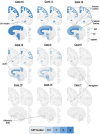Alpha-synuclein co-pathology in Down syndrome-associated Alzheimer's disease
- PMID: 40528443
- PMCID: PMC12173960
- DOI: 10.1002/alz.70342
Alpha-synuclein co-pathology in Down syndrome-associated Alzheimer's disease
Abstract
Introduction: Alpha-synuclein (αSyn) seed amplification assay (SAA) enables in vivo study of αSyn but remains underexplored in Down syndrome-associated Alzheimer's disease (DSAD).
Methods: We analyzed αSyn-SAA in cerebrospinal fluid (CSF) from 270 adults with Down syndrome, from the Down Alzheimer Barcelona Neuroimaging Initiative and from the AD21 cohort from the Department of Neurology at the University Hospital, Ludwig Maximilian University of Munich, Germany. Neuropathological examinations were conducted in 19 brain donors (five with ante mortem CSF). Participants were classified as asymptomatic or symptomatic (prodromal/dementia) Alzheimer's disease (AD). CSF Aβ1-42/1-40, CSF and plasma p-Tau181, and neurofilament light chain (NfL) levels were measured. Neuropathological evaluations assessed AD neuropathological changes and Lewy body pathology (LBP).
Results: ΑSyn-SAA was positive in 9.2% of cases, independent of age or cognitive status. Symptomatic αSyn-positive cases exhibited higher plasma NfL levels than αSyn-negative cases (31 vs 21 pg/mL, p = 0.027). LBP was observed in 47% of necropsies. The individual with severe neocortical LBP was αSyn-SAA-positive.
Discussion: These findings highlight LBP prevalence in DSAD but suggest current SAA may fail to detect limited αSyn deposition.
Highlights: αSyn-SAA positivity in DSAD is 9.2%, similar to ADAD but lower than sporadic AD. Misfolded αSyn was detectable from early ages in individuals with DS. Positivity rates did not vary with age or clinical status in DS. Plasma NfL levels are higher in symptomatic αSyn-SAA positive versus negative cases. CSF αSyn seeding activity was associated with high neocortical LBP at necropsy.
Keywords: Alzheimer's disease; Down syndrome; Lewy body pathology; biomarker; neuropathology; seed amplification assay; α‐synuclein.
© 2025 The Author(s). Alzheimer's & Dementia published by Wiley Periodicals LLC on behalf of Alzheimer's Association.
Conflict of interest statement
MCI reported receiving personal fees for service on the advisory boards, speaker honoraria or educational activities from Esteve, Lilly, Neuraxpharm, Adium, and Roche diagnostics. MRA has provided paid consultancy for Veranex and is a partner and director of production at Masima—Soluções em Imagens Médicas LTDA. DA reported receiving personal fees for advisory board services and/or speaker honoraria from Fujirebio‐Europe, Roche, Nutricia, Krka Farmacéutica, Lilly, Zambon S.A.U., Grifols, and Esteve, outside the submitted work. AL has served as a consultant or on advisory boards for Almirall, Fujirebio‐Europe, Roche, Biogen, Grifols, NovoNordisk, Novartis, Eisai, Lilly, and Nutricia, outside the submitted work. LMP has provided consultancy services to Biogen. JF reported serving on the advisory boards, adjudication committees, or speaker honoraria from Roche, NovoNordisk, Esteve, Biogen, Laboratorios Carnot, Adamed, LMI, Novartis, Lundbeck, Roche, AC Immune, Alzheon, Zambon, Lilly, Spanish Neurological Society, T21 Research Society, Lumind foundation, Jérôme‐Lejeune Foundation, Alzheimer's Association, NIH, USA, and Instituto de Salud Carlos III. JA reported receiving personal fees for service on speaker honoraria or educational activities from Lilly, Esteve, Fujirebio‐Europe, and Roche diagnostics. DA, AL, and JF report holding a patent for markers of synaptopathy in neurodegenerative disease (licensed to ADx, EPI8382175.0). JL reports speaker fees from Bayer Vital, Biogen, EISAI, Merck, Roche, TEVA, and Zambon; consulting fees from Axon Neuroscience, EISAI, and Biogen; author fees from Thieme Medical Publishers and W. Kohlhammer GmbH Medical Publishers; and is inventor in the patent “Oral Phenylbutyrate for Treatment of Human 4‐Repeat Tauopathies” (EP 23 156 122.6) filed by LMU Munich. In addition, he reports compensation for serving as chief medical officer for MODAG GmbH; is beneficiary of the phantom share program of MODAG GmbH; and is inventor in the patent “Pharmaceutical Composition and Methods of Use” (EP 22 159 408.8) filed by MODAG GmbH, all activities outside the submitted work. No other competing interests were reported. The author disclosures are available in the Supplementary Information.
Figures



References
MeSH terms
Substances
Grants and funding
- Ajuntament de Barcelona, in collaboration with Fundació La Caixa
- Anton and Petra Ehrmann-Stiftung
- German Ministry of Research and Education
- EXC-2145-SyNergy---ID 390857198/Deutsche Forschungsgemeinschaft
- 2326---GRT-2024A/Fondation Jérôme Lejeune
- the BrightFocus Foundation
- Horizon 2020 Framework Programme, MESCOBRAD
- IIBSP-DOW-2020-151/Fundación Tatiana Pérez de Guzmán el Bueno
- Departament de Salut, Generalitat de Catalunya
- AARFD-21-852492/ALZ/Alzheimer's Association/United States
- 1R01AG056850-01A1/NH/NIH HHS/United States
- 3RF1AG056850-01S1/NH/NIH HHS/United States
- AG056850/NH/NIH HHS/United States
- R21AG056974/NH/NIH HHS/United States
- R01AG061566/NH/NIH HHS/United States
- CIBERNED
- PI18/00335/Instituto de Salud Carlos III
- PI22/00785/Instituto de Salud Carlos III
- PI18/00435/Instituto de Salud Carlos III
- PI22/00611/Instituto de Salud Carlos III
- PI14/1561/Instituto de Salud Carlos III
- PI20/01330/Instituto de Salud Carlos III
- PI22/00307/Instituto de Salud Carlos III
- PI20/01473/Instituto de Salud Carlos III
- PI23/01786/Instituto de Salud Carlos III
- CP24/00112/Instituto de Salud Carlos III
- CM22/00052/Instituto de Salud Carlos III
- CM22/00219/Instituto de Salud Carlos III
- CM22/00291/Instituto de Salud Carlos III
- CM22/00243/Instituto de Salud Carlos III
- CP20/00038/Instituto de Salud Carlos III
- Life Molecular Imaging
- Fondo Europeo de Desarrollo Regional (FEDER)
- Fondo de Investigaciones Sanitario
- Fundació La Caixa
- Munich Cluster for Systems Neurology (SyNergy)
LinkOut - more resources
Full Text Sources
Medical
Miscellaneous

